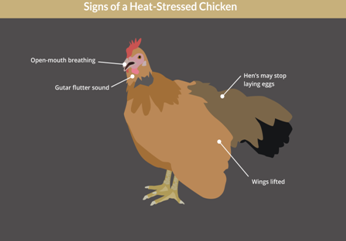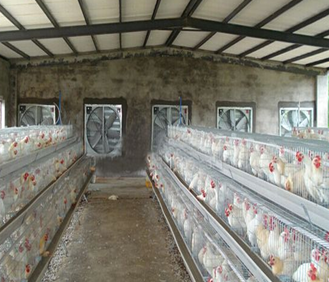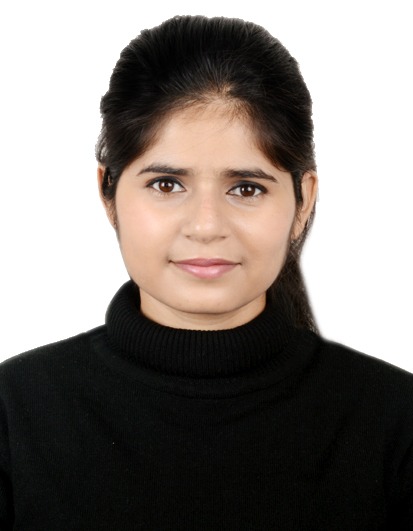Poultry is currently one of the fastest expanding businesses of India’s agricultural industry. This business faces a mishap due to rising global temperatures and the incontrovertible reality that current, high-yielding poultry breeds are more susceptible to heat stress. Heat stress sets in, when the ambient temperature rises above 80°F and becomes obvious above 85°F. Environmental temperature and humidity play a major role in heat stress. Thus it is important to measure both the temperature and humidity in the poultry shed.
SIGNS OF HEAT STRESS

Poultry are particularly susceptible to hot and humid weather and are at risk of overheating. Poultry subject to high environmental temperatures exhibit many behavioral and physiological changes which allow them to re-gain heat balance with their ambient environment. As ambient temperature increases above comfort zone, chicken spend less time in feeding, more time in drinking and panting, as well as more time with their wings elevated, less time moving or walking and more time in resting (Mack, et al., 2013). Birds pant to remove heat from their bodies, and are frequently seen extending their wings to allow heat to flow from less feathered body areas, such as under their wings, because they have a high normal body temperature and no sweat glands. This is a time-consuming exercise that needs more energy from the bird than merely sweating. Birds will eventually become exhausted due to heat exhaustion if they are not given relief from the heat.
Due to heat stress poultry exhibits various clinical signs such as panting, lethargy, reduced egg production, increased water intake, decreased feed intake, weakness, watery droppings etc.
MEASURES TO MITIGATE HEAT STRESS IN POULTRY
Providing Ventilation

In most circumstances, air flow may be used to control heat in your flock. Airflow at the level of the birds is critical for eliminating bird heat. The first aim should be to increase ventilation to reduce heat from the birds. However, there are several instances where ventilation is restricted. If the air is calm and additional fans are not available, naturally ventilated barns are at risk of heat stress. Barns that are mechanically ventilated may also be at risk if they lack adequate ventilation and air mixing for the size and quantity of birds present.
Drinking water
During heat stress, the bird attempts to maintain its body temperature by increasing respiration, which results in the evaporation of metabolic water, which can significantly increase the water need. Heat stress will increase their water intake by 2 to 4 times than their normal intake. Birds should have access to cool water at all times. The amount of space available for watering should be doubled. To keep the water cool, the overhead tanks and pipe system should be appropriately covered. Providing fresh cool water in the middle of the day is particularly beneficial for internal body cooling (heat sinks) and lowering stress symptoms. To keep the water fresh and cool, flush the water pipes and waterers on a regular basis.
Feeding
It is very critical to feed the birds at the proper time of day to assist them cope with heat stress. A considerable rise in body temperature can be noted in the late afternoon, which might result in bird mortality in severe situations. If the birds were fed in the early or mid morning, this is not the hottest time of day, but it is the peak time of digestion. Withdrawing feed 8 hours before the expected peak temperature is a smart method for reducing the heat burden on the birds. In the morning, one-third of the daily feed ration should be provided, followed by two-thirds in the late afternoon. Provision of calcium in the diet will also be fruitful as it will improve shell quality and prevent the birds from depleting bone calcium. Hence, this midnight snacking is a good tool to give hens extra feeding time in the cooler parts of the night.
Nutrient requirement
In the summer, increasing the nutritional density of the ration is a fairly straightforward strategy to assure optimal nutrient absorption despite lower feed consumption. To compensate for the lower consumption, the feed should be denser in nutrients, vitamins, and minerals. As the hot season advances, it may be essential to make some small adjustments in the feed formula once again in the middle of the summer. In addition, the following characteristics that affect heat stress management should be incorporated in the summer feed mix.
Using electrolyte
You can add electrolytes to your flock’s drinking water for up to three days. Heat stress causes increased loss of several minerals including potassium, sodium, phosphorus, magnesium and zinc. When potassium chloride electrolytes are added to drinking water at a concentration of 0.6 percent, they appear to improve water intake. Other potassium and sodium salts have been found to be less effective. You should start providing electrolytes prior to the heat stress period.
Using bicarbonate salts in water
For hens in the egg production industry, sodium bicarbonate in the feed or the usage of carbonated water is extremely beneficial. Panting and carbon dioxide emission can alter the acid-base balance in chicken, as well as the bicarbonate available for the development of egg shells. As a result, sodium bicarbonate can aid in the reduction of these alterations.
Supplementing vitamins
Supplementing broiler drinking water with vitamins (A, D, E, and B complex) can help reduce heat stress mortality. Vitamin C can successfully mitigate warm temperature reductions in laying hen egg production and eggshell quality, as well as sperm production in breeder males, in breeding poultry.
Other practices
- Delay poultry shed activities such as bird movement and litter conditioning.
- Reduce sun exposure in the poultry house or provide shade for pastured chickens.

Dr. Gunjan Sharma1, Dr. Divyanshu Singh Tomar1
1B.V.Sc. & A.H., M.V.Sc. (Animal Nutrition), Dr. G.C. Negi College of Veterinary and Animal Sciences, CSK Himachal Pradesh Agriculture University, Palampur, H.P. Contact: 8827552360 E-mail; nikki.gunjan16@gmail.com
2B.V.Sc & A.H., M.V.Sc (Livestock Production Management), ICAR- National Dairy Research Institute, Karnal, Haryana,
E-mail; dstomar26oct@gmail.com















